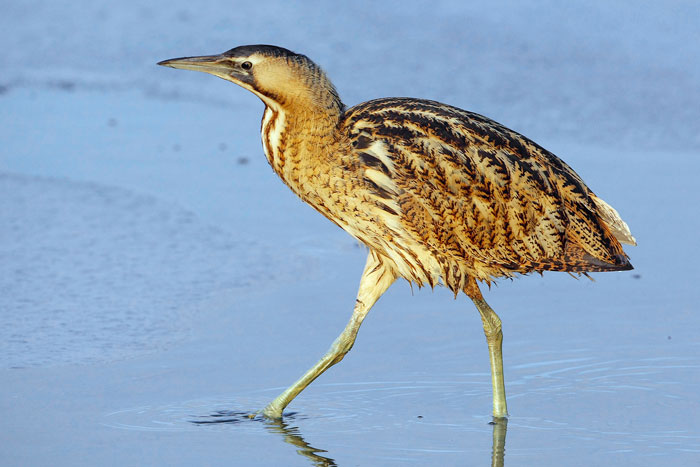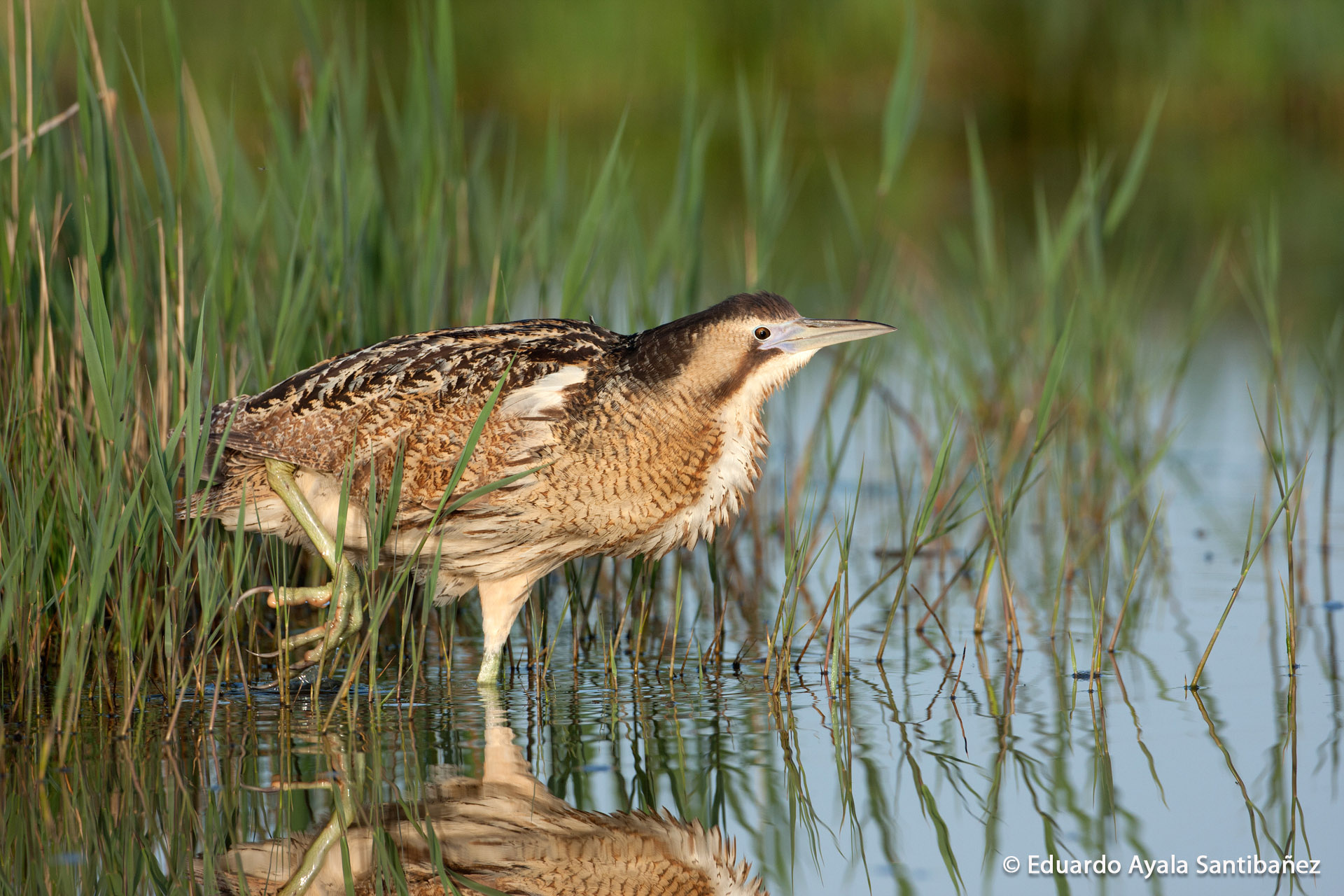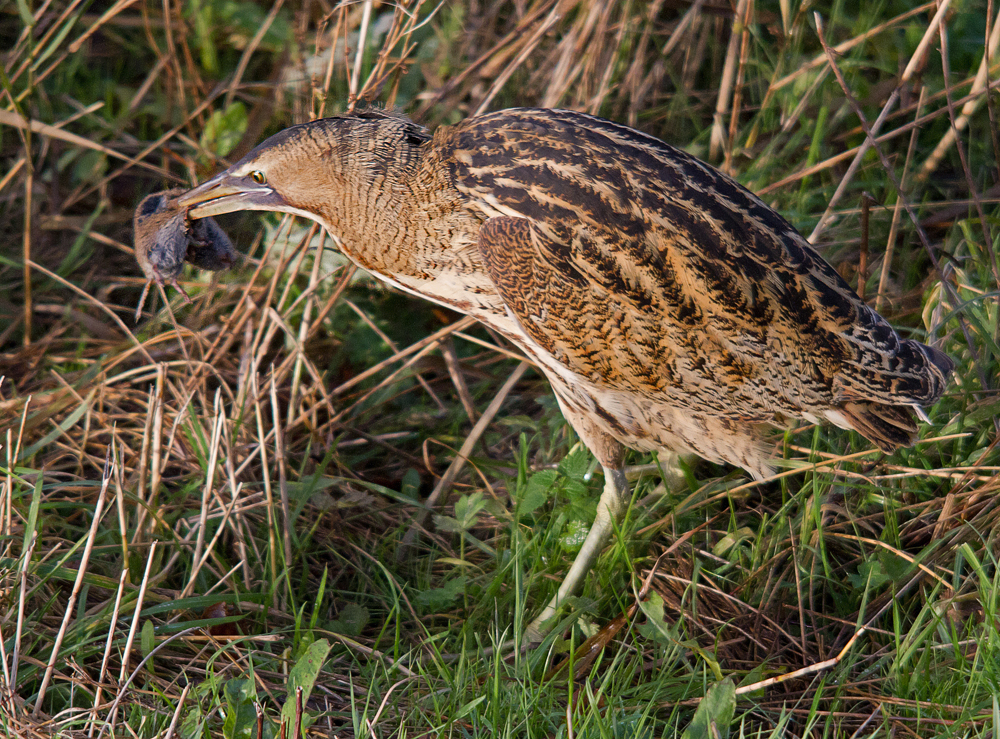
Botaurus stellaris
SUBFAMILY
Botaurinae
TAXONOMY
Ardea stellaris Linnaeus, 1758, Sweden. Two subspecies.
OTHER COMMON NAMES
English: Great bittern, common bittern; French: Butor йtoilй
German: Rohrdommel; Spanish: Avetoro Comъn.
PHYSICAL CHARACTERISTICS
A thick-necked, medium-sized, golden brown heron with a
black head and moustache. Length is 25–31 in (64–80 cm);
weight is 1.9–4.3 lb (0.9–1.9 kg). Its back is cryptic mottled
and mottled. It is the largest of the four species of large bitterns.
Males are significantly larger than females.
DISTRIBUTION
Occurs in the Old World temperate and tropical zones of Europe,
Asia, and Africa.
HABITAT
Occurs in densely vegetated wetlands. During the breeding
season, it is found only in reed beds characterized by dense
plants, stable shallow flooding, and with intermittent clearings
or channels. During the nonbreeding season, it uses more varied
and open aquatic habitats such as small ponds, gravel pits,
wet grassy meadows, ditches, tall rice fields, fish ponds, floating
leafed plant beds, and sewage lagoons.
BEHAVIOR
Hunts by walking with stealth in a crouched posture, the bill
pointed forward, and the feet lifted high with each step. Moves
about by climbing over the emergent stems, using long toes to
grasp the stems. Can hold a concealing
BEHAVIOR
, called the
bittern posture, for hours. In this posture, it raises its bill to
the sky and peers directly forward, swaying as if in the breeze
and turning slowly to keep eyes on a moving intruder.
A solitary feeder that fiercely defends its feeding and nesting
area during breeding using its booming call. The call consists
of two to four deep, resonant booms preceded by a few
short grunts or pumps, sometimes accompanied by clappering
the bill. It is aggressive in physically defending its site, and also
flies to supplant intruders and fights in the air, even to the
death.
FEEDING ECOLOGY AND DIET
Feeds at the edge of emergent reeds and open water, such as
along a pool, channel, or ditch, avoiding unflooded ground.
Primarily feeds in the morning and evening but is known to
hunt during the day and at night. Fish, amphibians, and insects
usually dominate the diet. Small mammals, birds, and snakes
are also taken.
REPRODUCTIVE BIOLOGY
Nests solitarily in spring and summer or in the rainy season in
the tropics. Non-migrating birds begin to call as early as late
winter. Nest is a pad of matted reeds and other marsh vegetation
that is built by the female. A polygamous species, males
may have up to five mates, each of which has a nest within the
male’s territory. Eggs are olive brown with spotting. The normal
clutch is four to five eggs; range is three to seven. Incubation
begins immediately, and the range of hatching dates for a
large clutch may stretch over two weeks. Only the female incubates,
lasting 25–26 days. Young can leave the nest after about
two weeks and fledge at 50–55 days.
CONSERVATION STATUS
The Eurasian bittern was formerly widespread and abundant,
but suffered significant population changes. In Europe, it declined
steadily since as early as the nineteenth century, being
extirpated from England in 1868. It began a comeback through
Europe in early 1900s, increased into the 1960s and then began
a second decline, in some cases very rapidly. It is now regionally
Vulnerable in Europe. The southern African
population is even more at risk, given its rapid decline over the
past several decades.
SIGNIFICANCE TO HUMANS
The Eurasian bittern occurs in reed beds and marshes
throughout its range. It is a skulking species that stays hidden,
at least during the day. It nonetheless is well known owing to
its booming call. This call has entered into folklore wherever
large bitterns occur, generally as a harbinger of evil.
Other popular Animals
Photo Gallery of - Eurasian bittern




 Animalia Life
Animalia Life